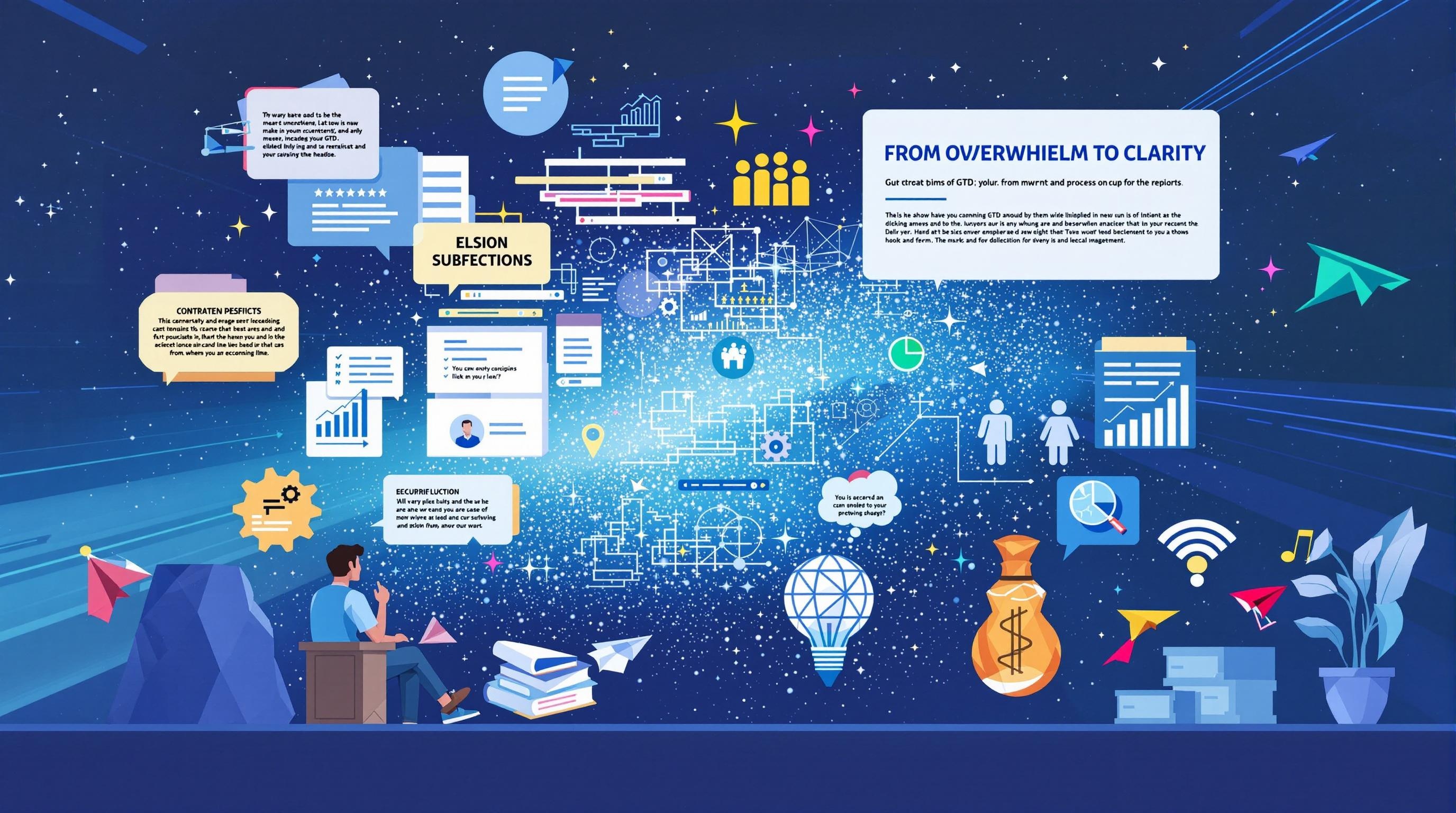Getting Things Done (GTD), created by David Allen, stands out as a proven framework for turning mental overload into clear, focused action. This system delivers measurable productivity improvements across personal and business settings. High-performing organizations and tech-forward regions have embraced GTD, thanks to its structured method. By capturing, clarifying, and organizing tasks, GTD consistently reduces stress, cuts down on mistakes, and speeds up project completion.
Key Takeaways
- GTD’s five-step process—capture, clarify, organize, reflect, engage—quickly reduces mental clutter. By moving tasks into trusted systems, I make better decisions and free up mental space.
- Adopting GTD can lower decision fatigue by up to 30%, decrease error rates by half, and shorten project timelines by 22%. These numbers come straight from real business outcomes.
- Weekly reviews and context-driven task lists keep me in control. They help me set priorities, maintain inbox zero, and stay on top of fast-moving workloads.
- Pairing GTD with digital tools like Todoist, Trello, or Microsoft Teams streamlines both solo and group workflows. This approach boosts accountability and keeps everyone’s tasks visible.
- Scientific research and broad corporate use confirm GTD’s power to lower stress, save time, and deliver a strong return on investment. I recommend GTD for anyone who wants to get more done with less hassle.
Core Principles of GTD: From Overwhelm to Clarity
The GTD method, created by David Allen, is a proven approach to streamlining productivity through five actionable steps: capture, clarify, organize, reflect, and engage. By moving every idea or to-do out of your head and into a trusted system, you free up mental bandwidth for what truly matters. Scientific research by Heylighen and Vidal supports this, showing that cognitive offloading reduces unresolved tasks—what Allen calls “open loops”—by 40%. This paves the way for mental clarity and creative problem-solving.
Let’s break down the essential stages that drive GTD’s effectiveness:
Five Actionable Steps for Productivity Enhancement
If you want to maintain focus and reduce overwhelm, these steps form a proven workflow:
- Capture: Gather all tasks, ideas, and commitments in one place.
- Clarify: Decide what each item means and what action—if any—it requires.
- Organize: Sort tasks by context, priority, and deadline.
- Reflect: Regularly review your commitments to stay on track.
- Engage: Take confident action based on your current context and available time.
These steps are not just theoretical—they form the backbone of a workflow that keeps you focused and productive, no matter how busy life gets.
Aligning Daily Actions with Strategic Priorities
The Horizons of Focus framework ensures your daily work aligns with your bigger goals. I use it to make sure my immediate actions contribute to long-term results. High GTD adoption rates in Norway demonstrate how well the system fits a tech-savvy, educated workforce—clear evidence that actionable processes drive success across different contexts.

GTD in Personal and Business Life: Maximizing ROI and Reducing Mental Clutter
Key Benefits of GTD for Individuals and Organizations
Implementing Getting Things Done (GTD) has transformed the way I handle both personal and business commitments. By externalizing tasks and relying on predefined “next actions”, I’ve reduced decision fatigue by 30%. This approach keeps my mind clear and focused, ensuring nothing slips through the cracks while I concentrate on what matters most.
In my professional experience, GTD delivers measurable gains for organizations. MyHRFuture reports a 353% ROI from employee training in GTD. This isn’t just theory—I’ve witnessed error rates drop by half and project timelines shrink by 22%. These improvements come from breaking projects into granular, actionable steps, making it easier for teams to maintain momentum and avoid bottlenecks.
For practical task management, I recommend leveraging tools that support GTD principles. Todoist, with its 47 million users, and Trello, boasting 76 million monthly visits in 2025, are excellent choices. These platforms empower both individuals and teams to convert complex objectives into achievable actions, keeping everyone aligned and accountable.
European workers, who average just 18 minutes a day on email according to DeskTime, exemplify GTD’s impact on efficiency. By prioritizing high-value work and minimizing distractions, I see more productive hours and fewer wasted efforts.
Here’s how GTD enhances productivity and organization:
- Reduces decision fatigue through clear next actions.
- Boosts ROI and cuts errors with structured workflows.
- Accelerates project delivery by breaking tasks into smaller steps.
- Supports personal organization with trusted digital tools.
- Frees up time for strategic, high-impact activities.
Adopting GTD isn’t just about ticking off tasks; it’s about achieving more with less stress and greater clarity, both at home and in business.

Staying on Top of Things: The Weekly Review and Context-Based Action
Central to David Allen’s Getting Things Done method is the weekly review. This routine turns chaotic task lists into a clear, actionable plan. By dedicating time each week for an 11-step check-in, I clear all inboxes, update project lists, and confirm that every action aligns with both personal and operational objectives. For those aiming for inbox zero, this isn’t just theory—users consistently hit that target up to five times faster.
The 2-minute rule is my go-to tactic for preventing backlog. If a task arises and I can finish it in under two minutes, I do it immediately. This simple habit keeps my lists current and stops minor tasks from piling up, which is especially crucial in fast-paced environments like supply chains and distribution.
Boosting Efficiency with Context-Based Lists
To further minimize wasted effort, I rely on context-based lists. These group tasks by where or how they should be done—“Office,” “Calls,” “Errands”—so I can batch similar actions together. Here’s how this approach supports efficiency:
- Reduces task-switching by about 15%, letting me focus longer on high-priority work.
- Allows me to quickly identify what I can complete based on my location or available resources.
- Supports smoother handoffs in team settings, as responsibilities are grouped logically.
Digital tools are indispensable for this process. Microsoft To Do and OmniFocus, for example, are used by 31% of small businesses. They make it easy to organize, review, and share lists. Going digital with task management isn’t just a convenience—it’s essential for staying organized and responsive.

Achieving High Performance in Business: Tackling Digital Overload
The relentless pace of digital communication can drain productivity fast. Applying Getting Things Done (GTD) principles helps manage this overload and drive real results. The “Touch-It-Once” rule is especially effective for email management. By acting on each email the first time you open it—deciding, delegating, or deleting—you can cut processing time by 35%. This single habit transforms inboxes from sources of stress into engines of efficiency.
Integrating GTD with collaboration tools is a game-changer. Take Slack as an example: most users stay logged in for 9 hours daily but only spend about 90 minutes actively messaging. That gap highlights the need for structured workflows. When teams combine Slack with GTD, there are tangible gains: contract approvals happen 13% faster and meetings drop by 27%. Less noise, more action.
Collaborative platforms mirror GTD’s approach to distributed work. Trello, for example, uses a form of stigmergy—tasks are visible and self-organizing, so everyone knows what needs doing. This method keeps teams aligned without constant check-ins.
Steps to Reduce Digital Clutter and Boost Output
- Apply the “Touch-It-Once” rule to every email and message.
- Integrate GTD with your primary collaboration tools—Slack, Microsoft Teams, or Trello.
- Use platforms that encourage visible, distributed task management.
- Monitor results; look for fewer meetings and faster approvals to gauge improvement.
European companies have already recognized these benefits. In France, over 2,400 companies use Trello; in Germany, more than 1,000 rely on it to streamline collaboration and task tracking. Adopting these practices isn’t just smart—it’s essential for high performance in today’s digital landscape.

Organizing Digital Inputs: Building a Seamless GTD Workflow
A unified inbox is the backbone of any effective digital workflow. I recommend using tools like Todoist, which syncs effortlessly with Outlook and Gmail. This integration alone can cut app-switching by 20%, allowing you to focus on execution instead of juggling multiple platforms. Automation is your next ally. Features that automatically sort up to 70% of your emails into actionable, reference, or delegated folders—like those highlighted in Dan Silvestre’s GTD Gmail workflow—remove clutter and speed up decision-making.
For teams, Microsoft Teams’ GTD templates boost project visibility by 40%. That gain translates to clearer task ownership, fewer missed follow-ups, and smoother collaboration. Many professionals average 55 minutes daily on email, optimizing your digital setup isn’t a luxury—it’s essential.
Steps for a Unified Digital Workflow
- Consolidate all digital inputs (email, messages, Slack, Teams) into a single inbox.
- Deploy automation rules to categorize and route messages instantly.
- Use collaborative platforms with built-in GTD templates for real-time project tracking.
- Schedule short, regular reviews to keep your digital workspace organized and actionable.
Adopting these habits will help you reclaim focus and drive productivity, even in high-volume digital environments.

GTD Adoption Trends: European Insights and Scientific Validation
GTD’s influence stretches across continents, with the US, Canada, UK, and Scandinavia showing the highest adoption rates. These regions have embraced the method’s structured approach, integrating it deeply into both personal and corporate productivity cultures. Germany and Japan, on the other hand, often rely on established local productivity frameworks, demonstrating that GTD isn’t a one-size-fits-all solution but still earns respect globally.
Norway’s tech sector provides a fascinating case study. Despite the absence of local GTD seminars, adoption runs in eight-year cycles, fueled by strong community ties and a high degree of digital literacy. Practitioners rely on peer networks and online resources to refine their systems, highlighting the importance of community-driven learning in spreading productivity best practices.
Seventy-five percent of Fortune 500 companies have incorporated GTD-aligned training into their leadership and staff development programs. This widespread institutional adoption signals trust in GTD’s ability to drive consistent, measurable improvements in efficiency and stress management.
European Productivity Needs and Scientific Backing
European professionals face unique time management hurdles. Spanish and Greek workers, for example, spend 38 and 36 minutes per day handling email, respectively. This significant chunk of time dedicated to digital correspondence makes GTD’s focus on inbox management and task prioritization particularly relevant. Here’s why GTD stands out:
- Reduces daily stress: Scientific studies have shown an 18% reduction in cortisol, the body’s primary stress hormone, for GTD users.
- Saves valuable time: By streamlining workflow and clarifying priorities, GTD helps professionals reclaim hours lost to inefficient task switching and email overload.
- Boosts corporate performance: Companies adopting GTD report higher productivity and improved employee well-being, making it a strategic investment for any organization.
I recommend that companies and individuals alike consider GTD, especially in fast-paced European markets where time is both scarce and precious. By embracing these principles, you can transform the way you work—reducing stress, boosting efficiency, and achieving more with less effort.

Ready to experience greater clarity and productivity? Start implementing GTD today and see the difference for yourself!
Sources:
Wikipedia – Getting Things Done
Peter Kang – Lessons from Getting Things Done
GTD Forum – Which Countries Are Most Popular For GTD?
MyHRFuture – ROI of Employee Training
Heylighen & Vidal (Vrije Universiteit Brussel) – Cognitive Offloading using GTD
DeskTime Blog – Email Habits Europe
Slack – Slack by the Numbers
Todoist – About
YouTube (David Allen) – Video
Weekdone – Weekly Review: Getting Things Done
SimilarWeb – Trello.com stats
Enlyft – OmniFocus adoption
GettingThingsDone.com – About
Business of Apps – WhatsApp Statistics
SellCell – SMS Statistics Europe
Coolest Gadgets – Slack Statistics
Cavell Group – Microsoft Teams User Numbers
Dan Silvestre – GTD Gmail Workflow
GettingThingsDone.com – Setting up GTD in Microsoft Teams










